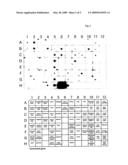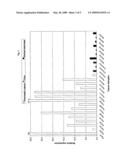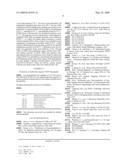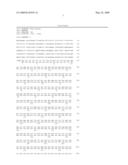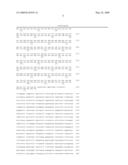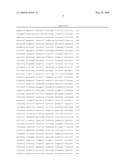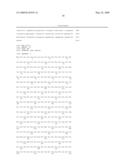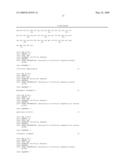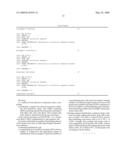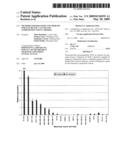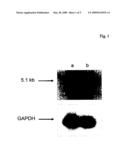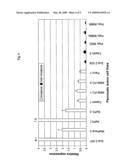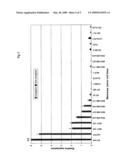Patent application title: Methods for diagnosis and therapy for pancreatic cancer and composition useful therein
Inventors:
Malte Buchholz (Lonsee, DE)
Thomas Gress (Elchingen, DE)
Stephanie Loesch (Penzberg, DE)
Ulrich Weidle (Muenchen, DE)
IPC8 Class: AC12Q168FI
USPC Class:
435 6
Class name: Chemistry: molecular biology and microbiology measuring or testing process involving enzymes or micro-organisms; composition or test strip therefore; processes of forming such composition or test strip involving nucleic acid
Publication date: 2009-05-28
Patent application number: 20090136939
Claims:
1. A method for the detection of pancreatic tumor, comprising:a)
incubating a sample from a patient suspected of suffering from pancreatic
cancer, said sample containing mRNA and being selected from the group
consisting of body fluid, cells, and a cell extract, with a nucleic acid
probe which is selected from the group consisting of(i) the nucleic acid
shown in SEQ ID NO: 1 or a nucleic acid which is 100% complementary to
said sequence, and(ii) nucleic acids which are capable of hybridizing
with one of the nucleic acids from (i) under high stringent hybridization
conditions;b) detecting hybridization; andc) comparing the level of mRNA
encoding UKW in the test sample, as evidenced by the approximate amount
of hybridization of the test sample, to the level of mRNA of a
housekeeping gene in the same test sample to identify whether or not the
test sample contains an at least 3-fold greater level of mRNA encoding
UKW in comparison to the level of mRNA of said housekeeping gene and
therefrom determining whether the test sample contains pancreatic tumor
cells;said high stringent hybridization conditions being conditions
involving washing said nucleic acids with a solution of 5.times.SSC, 0.5%
SDS, 1.0 mmol/l EDTA, pH 8.0, then hybridizing said nucleic acids at 65
to 70.degree. C. in 5.times.SSC overnight, then washing said nucleic
acids at room temperature for 40 minutes with 2.times.SSC containing 0.1%
SDS and afterwards washing said nucleic acids with 0.1.times.SSC, 0.1%
SDS at 50.degree. C. for 40 minutes with one change of fresh solution.Description:
PRIORITY TO RELATED APPLICATIONS
[0001]This application is a continuation of U.S. application Ser. No. 10/696,487, filed Oct. 29, 2003, now pending; which claims the benefit of European Application No. 02024539.5 filed Oct. 31, 2002. The entire contents of the above-identified applications are hereby incorporated by reference.
BACKGROUND OF THE INVENTION
[0002]The present invention generally relates to methods for diagnosis of pancreatic cancer, compositions useful therefore and therapeutic methods for the treatment of pancreatic cancer.
[0003]Pancreatic cancer is a cancer type which is difficult to diagnose and to control and most of such cancers can grow very rapidly.
[0004]Neoplasms of the exocrine pancreas may arise from ductal, acinar and stromal cells. Eighty percent of pancreatic carcinomas are derived from ductal epithelium. 60% of these tumors are located in the head of the pancreas, 10% in the tail and 30% are located in the body of the pancreas or are diffuse (Warshau, A. L., and Fernandez-del, C. C., N. Engl. J. Med. 326 (1992) 4555-4565). Histologically, these tumors are graded as well as differentiated, moderately differentiated and poorly differentiated. Some tumors are classified as adenosquamous, mucinous, undifferentiated or undifferentiated with osteoblast-like giant cells (Gibson, J. B., and Sobin, L. H., Histological typing of tumors of the liver, biliary tract and pancreas, WHO, Geneva, 1978). Since the disease is asymptomatic in its early stages, because of the lack of any test for early diagnosis and due to its aggressive character with respect to metastasis locally and to visceral organs, this disease is associated with a dismal prognosis. Only 20% of the tumors are resectable and the survival benefit of approved chemotherapy regiments is rather poor (Kroep, J. R., et al., Ann. Oncol. 10, Suppl. 4 (1999) 234-238). Identification of new targets for early diagnosis of pancreatic tumors is therefore a challenge of paramount importance.
[0005]WO 02/08288 describes secreted and transmembrane polypeptides and nucleic acids encoding the same. FIG. 130 shows the polypeptide sequence of UKW.
SUMMARY OF THE INVENTION
[0006]It was surprisingly found that nucleic acids coding for polypeptide UKW are overexpressed specifically in pancreatic tumor cells, whereas expression is considerably lower in normal pancreatic cells or in tumor cells of other origin, e.g., breast cancer or colon cancer cells. Therefore, UKW is a valuable new target for specific diagnosis and therapy of pancreatic cancer.
[0007]According to one aspect of the present invention, a method for determining the presence or absence of pancreatic cancer in a patient comprises [0008](i) obtaining a biological sample from a patient; [0009](ii) detecting in the sample an amount of nucleic acid encoding UKW or an amount of polypeptide UKW; and [0010](iii) comparing the amount of nucleic acid or polypeptide with a predetermined standard value indicating the decision line for tumor-induced or non-tumor-induced UKW expression or presence in the cell and therefrom determining the presence or absence of pancreatic cancer in the patient.
[0011]Preferably, the detection is performed by the use of a binding agent which binds to UKW nucleic acid or polypeptide. More preferably, the binding agent is a probe hybridizing under stringent conditions with UKW nucleic acid or an antibody, preferably a monoclonal antibody binding to UKW polypeptide, preferably to the extracellular domain.
[0012]According to another aspect of the present invention, there is provided a process for determining whether or not a test sample of tissue or fluid of a patient contains pancreatic tumor cells or is derived from pancreatic tumor cells, wherein the test sample and a second sample originating from non-pancreatic-tumor cells from the same individual or a different individual of the same species are used, which process comprises the following steps: [0013](a) incubating each respective sample under stringent hybridization conditions with a nucleic acid probe which is selected from the group consisting of: [0014](i) a nucleic acid sequence of SEQ ID NO: 1, or a fragment thereof; [0015](ii) a nucleic acid sequence which is complementary to any nucleic acid sequence of (i); [0016](iii) a nucleic acid sequence which hybridizes under stringent conditions with the sequence of (i); and [0017](iv) a nucleic acid sequence which hybridizes under stringent conditions with the sequence of (ii); and [0018](b) determining the approximate amount of hybridization of each respective sample with said probe, and [0019](c) comparing the approximate amount of hybridization of the test sample to an approximate amount of hybridization of said second sample to identify whether or not the test sample contains a greater amount of the specific nucleic acid or mixture of nucleic acids than does said second sample.
[0020]According to a further aspect of the present invention, a method for the detection of pancreatic tumors, comprises [0021]a) incubating a sample of a patient suspected of suffering from pancreatic cancer, selected from the group of body fluid, of cells, or of a cell extract or cell culture supernatants of said cells, whereby said sample contains nucleic acids with a nucleic acid probe which is selected from the group consisting of [0022](i) the nucleic acid shown in SEQ ID NO:1 or a nucleic acid which is complementary to said sequence, and [0023](ii) nucleic acids which hybridize with one of the nucleic acids from (i) and [0024]b) detecting hybridization, preferably by means of a further binding partner of the nucleic acid of the sample and/or the nucleic acid probe or by X-ray radiography.
[0025]Both methods can also be performed by the use of antibodies, whereby the UKW polypeptide is detected by interaction between the antibody and the polypeptide.
[0026]The invention further provides a method for monitoring the progression of pancreatic cancer in the patient. In such a method, the amount of UKW nucleic acid or polypeptide in a biological sample (e.g., body fluids such as blood, cell lysates or a reverse transcript of an RNA sample) of a patient suffering from pancreatic cancer is determined at least two different points in time and compared. From the change of the amount, information on the progression of said pancreatic cancer can be deduced.
[0027]The invention further comprises diagnostic kits comprising one or more oligonucleotide probes or primers for hybridization with UKW nucleic acid in a diagnostic assay using a sample obtained from a patient suffering from, or being suspected to have, pancreatic cancer.
[0028]The invention further comprises the use of antibodies against UKW polypeptide in a therapeutically effective amount in the treatment of pancreatic cancer. Preferably, the antibody is administered locally to the pancreas and especially preferably to the head of the pancreas.
[0029]In a further embodiment of the invention, the antibody against UKW polypeptide is administered to the patient in a therapeutically effective amount for the treatment of pancreatic cancer diseases and/or for preventing and/or inhibiting metastasis caused by pancreatic cancer diseases.
[0030]The above, and other objects, features and advantages of the present invention will become apparent from the following description read in conjunction with the accompanying drawings.
BRIEF DESCRIPTION OF THE DRAWINGS
[0031]FIG. 1 Differential expression of UKW mRNA in pancreatic tumor cell lines SUIT-2 007 and SUIT-2 028 analyzed by Northern blot analysis.
(a: pancreatic tumor cell line SUIT-2 007; b: pancreatic tumor cell line SUIT-2 028)
[0032]FIG. 2 Multiple Tissue Expression (MTE®) Array (Clontech, Palo Alto, Calif., USA). This array contains normalized loadings of poly A+-RNA from 76 different tissues as well as control RNA's and DNA's and enables to screen for the presence and relative abundance of a target mRNA in a broad spectrum of fetal and adult tissues. H6 corresponds to 1 μg total RNA from pancreatic tumor cell line SUIT-2 007. The code is revealed below.
[0033]FIG. 3 Relative expression (Taqman©-PCR) of mRNA in samples derived from adenocarcinomas of the pancreas (PaCa), chronic pancreatitis (ChronPa) and normal pancreatic tissues (NorPA).
[0034]FIG. 4 Relative expression of UKW mRNA in invasive and non-invasive pancreatic tumor cell lines.
[0035]FIG. 5 Relative expression of UKW mRNA in invasive and non-invasive mammary tumor cell lines.
DETAILED DESCRIPTION OF THE INVENTION
[0036]As used herein, the term "UKW" means a nucleic acid encoding a polypeptide of SEQ ID NO:2, preferably the DNA sequence and the related mRNA sequence of SEQ ID NO:1 as well as the encoded polypeptide of SEQ ID NO:2. As UKW is a transmembrane receptor protein, the polypeptide is of outstanding interest for diagnosis and as an epitope for antibody binding the extracellular domain of UKW polypeptide is preferred. Therefore, it is preferred to direct the nucleic acid sample and probes to this region and especially to parts thereof which have low homology with other genes and polypeptides.
[0037]The UKW receptor is a transmembrane protein composed of 373 amino acids with a signal sequence of 18 amino acids. The receptor consists of an extracellular domain of 215 amino acids, a transmembrane domain of 23 amino acids and a cytoplasmic domain of 117 amino acids. The extracellular domains displays two immunoglobulin C2-type folds composed of 93 amino acids and 72 amino acids.
[0038]The phrase "nucleic acid or polypeptide" as used throughout this application refers to a nucleic acid or polypeptide having a UKW activity which is substantially free of cellular material or culture medium when produced by recombinant DNA techniques, or substantially free of chemical precursors or other chemicals when synthesized chemically. Such a nucleic acid is preferably free of sequences which naturally flank the nucleic acid (i.e. sequences located at the 5' and the 3' ends of the nucleic acid) in the organism from which the nucleic acid is derived.
[0039]"Nucleic acid probes and primers for UKW" as used herein means nucleic acid fragments useful for the detection of UKW nucleic acids by hybridization methods. Hybridization techniques and conditions are well-known to one skilled in the art. Such hybridization conditions are, for example, moderate stringent conditions including washing with a solution of 5×SSC, 0.5% SDS, 1.0 mmol/l EDTA, pH 8.0, followed by hybridization at 50-60° C. 5×SSC overnight, washing at room temperature for 40 minutes with 2×SSC containing 0.1% SDS and afterwards washing with 0.1×SSC, 0.1% SDS at 50° C. for 40 min with one change of fresh solution. It is also possible to use higher temperatures for hybridization (e.g. 65-70° C.) as high stringent hybridization conditions. The nucleic acid probes and primers usually consist of a UKW nucleic acid segment of at least about 50 contiguous positions most preferably of 200 to 300 nucleotides The optimization of the probes and primers can be performed according to the state of the art. There exists informatic software (http://www-genome.wi.mit.edu/genome_software/other/primer3.html) which is generally used for such probe and primer design. For high selectivity it is preferred to use relatively low salt and/or high temperature conditions, for example, a salt concentration from about 0.02 mol/l to about 0.15 mol/l and temperatures of from about 50° C. to about 70° C.
[0040]UKW polypeptides can be identified in diagnostic assays using specific probes and primers. Usually such methods include amplifying the target sequence in the sample by amplification methods such as the PCR method. Quantitative detection can be performed by PCR techniques, preferably by the use of quantitative RT-PCR using, e.g., the LightCycler® of Roche Diagnostics GmbH, DE.
[0041]In a preferred embodiment of the invention the coding nucleic acid of the sample is amplified before the test, for example by means of the known PCR technique. Usually a derivatized (labeled) nucleic acid probe is used within the framework of nucleic acid diagnostics. This probe is contacted with a denatured DNA, RNA or RT-DNA from the sample which is bound to a carrier and in this process the temperature, ionic strength, pH and other buffer conditions are selected--depending on the length and composition of the nucleic acid probe and the resulting melting temperature of the expected hybrid--such that the labeled DNA or RNA can bind to homologous DNA or RNA (hybridization see also Wahl, G. M., et al., Proc. Natl. Acad. Sci. USA 76 (1979) 3683-3687). Suitable carriers are membranes or carrier materials based on nitrocellulose (e.g., Schleicher and Schull, BA 85, Amersham Hybond, C.), strengthened or bound nitrocellulose in powder form or nylon membranes derivatized with various functional groups (e.g., nitro groups) (e.g., Schleicher and Schull, Nytran; NEN, Gene Screen; Amersham Hybond M.; Pall Biodyne).
[0042]To determine whether a test sample contains pancreatic tumor cells, the approximate amount of hybridization of the nucleic acid with the target nucleic acid or nucleic acids is determined. The approximate amount of hybridization need not be determined quantitatively, although a quantitative determination is encompassed by the present invention. Typically, the approximate amount of hybridization is determined qualitatively, for example, by a sight inspection upon detecting hybridization. For example, if a gel is used to resolve labelled nucleic acid which hybridizes to target nucleic acid in the sample, the resulting band can be inspected visually. When performing a hybridization of isolated nucleic acid which is free from pancreatic tumor cells from an individual of the same species, the same protocol is followed. One can compare the approximate amount of hybridization in the test sample to the approximate amount of hybridization in the sample free from pancreatic tumor cells, to identify whether or not the test sample contains a greater amount of the target nucleic acid or nucleic acids than does the sample which is free from pancreatic tumor cells.
[0043]In a further method according to the invention no second sample is used. For the detection whether the expression of UKW gene is upregulated, the level of mRNA of UKW is compared with the level of mRNA of a standard gene (housekeeping gene (see, e.g., Shaper, N. L., et al., J. Mammary Gland Biol. Neoplasia 3 (1998) 315-324; Wu, Y. Y., and Rees, J. L., Acta Derm. Venereol. 80 (2000) 2-3) of the cell, preferably by RT-PCR.
[0044]As is shown in accordance with the present invention, the UKW nucleic acid is expressed in a greater amount in a pancreatic tumor sample than in a sample free from pancreatic_tumor cells and/or in a greater amount than a housekeeping gene. A test sample containing pancreatic tumor cells will have a greater amount of the UKW nucleic acid than does a sample which is free from pancreatic tumor cells. To identify a test sample as containing upregulated UKW nucleic acid, i.e., wherein the cells are pancreatic tumor cells or are tumor cells of a mammary carcinoma, it is preferable that the test sample have an approximate amount of UKW nucleic acid which is appreciably greater than the approximate amount in a sample free of pancreatic tumor cells. For example, a test sample having an upregulated UKW gene may have approximately 15- to approximately 60-fold increased amount of UKW gene than a sample free of pancreatic tumor cells or an at least 3-fold greater amount of UKW mRNA than mRNA of a housekeeping gene like glycerolaldehyde-3-phosphate dehydrogenase (GAPDH) or porphobilinogen deaminase.
[0045]Methods of hybridization of a probe and a nucleic acid are known to a person skilled in the art and are described, for example, in WO 89/06698, EP-A 0 200 362, U.S. Pat. No. 2,915,082, EP-A 0 063 879, EP-A 0 173 251, EP-A 0 128 018.
[0046]Hybridizing DNA or RNA is then detected by incubating the carrier with an antibody or antibody fragment after thorough washing and saturation to prevent unspecific binding. The antibody or the antibody fragment is directed towards the substance incorporated during hybridization to the nucleic acid probe. The antibody is in turn labeled. However, it is also possible to use a directly labeled DNA. After incubation with the antibodies it is washed again in order to only detect specifically bound antibody conjugates. The determination is then carried out according to known methods by means of the label on the antibody or the antibody fragment.
[0047]The detection of the expression can be carried out for example as: [0048]in situ hybridization with fixed whole cells, with fixed tissue smears, [0049]colony hybridization (cells) and plaque hybridization (phages and viruses), [0050]Southern hybridization (DNA detection), [0051]Northern hybridization (RNA detection), [0052]serum analysis (e.g., cell type analysis of cells in the serum by slot-blot analysis), [0053]after amplification (e.g., PCR technique).
[0054]The nucleic acids according to the invention are hence valuable markers in the diagnosis and characterization of pancreatic tumors.
[0055]According to the invention inhibitors for the expression of UKW (e.g., antibodies or antisense nucleotides) can be used to inhibit pancreatic tumor progression in vivo.
[0056]The invention further provides methods for the identification and isolation of antagonists of UKW or inhibitors for the expression of UKW (e.g., antibodies and antisense nucleotides). Such antagonists or inhibitors can be used to inhibit pancreatic tumor progression and cause massive apoptosis of pancreatic tumor cells in vivo.
[0057]According to the invention there are provided methods for identifying and isolating of UKW antagonists which have utility in the treatment of cancer. These methods include methods for modulating the expression of the polypeptides according to the invention, methods for identifying UKW antagonists which can selectively bind to the proteins according to the invention, and methods of identifying UKW antagonists which can modulate the activity of said polypeptides. The methods further include methods for modulating, preferably inhibiting, the transcription of UKW gene to mRNA. These methods can be conducted in vitro or in vivo and may make use of and establish cell lines and transgenic animal models of the invention.
[0058]A UKW antagonist is defined as a substance or compound which decreases or inhibits the biological activity of UKW, a polypeptide and/or inhibits the transcription or translation of UKW gene. In general, screening procedures for UKW antagonists involve contacting candidate substances with host cells in which invasiveness is mediated by expression of UKW under conditions favorable for measuring UKW activity.
[0059]UKW activity may be measured in several ways. Typically, the activation is apparent by a change in cell physiology, such as increased mobility and invasiveness in vitro, or by a change in the differentiation state, or by a change in cell metabolism leading to an increase of proliferation.
[0060]The UKW polypeptides can be produced by recombinant means or synthetically. Non-glycosylated UKW polypeptide is obtained when it is produced recombinantly in prokaryotes. With the aid of the nucleic acid sequences provided by the invention it is possible to search for the UKW gene or its variants in genomes of any desired cells (e.g. apart from human cells, also in cells of other mammals), to identify these and to isolate the desired gene coding for the UKW proteins. Such processes and suitable hybridization conditions are known to a person skilled in the art and are described, for example, by Sambrook et al., Molecular Cloning: A Laboratory Manual (1989) Cold Spring Harbor Laboratory Press, New York, USA, and Hames, B. D., Higgins, S. G., Nucleic Acid Hybridisation--A Practical Approach (1985) IRL Press, Oxford, England. In this case the standard protocols described in these publications are usually used for the experiments.
[0061]With the aid of such nucleic acids coding for a UKW polypeptide, the polypeptide according to the invention can be obtained in a reproducible manner and in large amounts. For expression in prokaryotic or eukaryotic organisms, such as prokaryotic host cells or eukaryotic host cells, the nucleic acid is integrated into suitable expression vectors, according to methods familiar to a person skilled in the art. Such an expression vector preferably contains a regulatable/inducible promoter. These recombinant vectors are then introduced for the expression into suitable host cells such as, e.g., E. coli as a prokaryotic host cell or Saccharomyces cerevisiae, teratocarcinoma cell line PA-1, sc 9117 (Buttner, R., et al., Mol. Cell. Biol. 11 (1991) 3573-3583), insect cells, CHO or COS cells as eukaryotic host cells and the transformed or transduced host cells are cultured under conditions which allow expression of the heterologous gene. The isolation of the protein can be carried out according to known methods from the host cell or from the culture supernatant of the host cell. Such methods are described for example by Ausubel I., Frederick M., Current Protocols in Mol. Biol. (1992), John Wiley and Sons, New York. Also in vitro reactivation of the protein may be necessary if it is not found in soluble form in the cell culture.
[0062]UKW polypeptide or fragments thereof can be purified after recombinant production by affinity chromatography using known protein purification techniques, including immunoprecipitation, gel filtration, ion exchange chromatography, chromatofocussing, isoelectric focussing, selective precipitation, electrophoresis, or the like and can be used for the generation of antibodies against UKW.
[0063]The invention further comprises recombinant expression vectors which are suitable for the expression of UKW, recombinant host cells transfected with such expression vectors, as well as a process for the recombinant production of a protein which is encoded by the UKW gene.
[0064]Antibodies against UKW can be produced according to the methods known in the state of the art. For example, monoclonal or polyclonal antibodies can be produced using a polypeptide comprising about 10 to 100 amino acids of the UKW polypeptide sequence. Suitable polypeptides derived from UKW include preferably amino acids from the extracellular domain, preferably amino acids 70-80, 99-113, 120-140 and 167-182.
[0065]The resulting antibodies can be screened for the ability to bind to UKW using standard techniques such as enzyme-linked immunoabsorbent assays. Methods for identifying antigen epitopes and for the production of antibodies are described, for example, in Mole, "Epitope Mapping", In: Methods in Molecular Biology, Vol. 10, Manson (ed.), pages 105-116, The Humana Press, Inc., 1992; Price, "Production and Characterization of Synthetic Peptide-Derived Antibodies", In: Monoclonal Antibodies: Production, Engineering, and Clinical Application, Ritter and Ladyman (eds.), pp. 60-84, Cambridge University Press, 1995; Morris (ed.), Epitope Mapping Protocols 25, Humane Press, Inc., 1996; and Coligan et al. (eds.), Current Protocols in Immunology, pp. 9.3.1-9.3.5 and pp. 9.4.1-9.4.11, John Wiley & Sons, 1997.
[0066]Antibodies which are useful according to the invention, especially for therapeutic purposes, can be identified by reducing the proliferation and invasive potential of pancreatic tumor cells. For this purpose, pancreatic tumor cells or a pancreatic tumor cell line, preferably cell line SUIT-2 007 are treated with an antibody against UKW and proliferation and invasive potential are measured by Cell Proliferation Reagent WST-1 (a tetrazolium salt reagent, Roche Diagnostics GmbH, DE) and Matrigel invasion assay (BDS Biosciences, www.bdbiosciences.com).
[0067]Anti-UKW antibodies can be derived from any animal species or are chimeric or humanized antibodies. Especially preferred are human antibodies. Human monoclonal antibodies are obtained, for example, from transgenic mice that have been engineered to produce specific human antibodies in response to antigenic challenge. In this technique, elements of the human heavy and light chain locus are introduced into strains of mice derived from embryonic stem cell lines that contain targeted disruptions of the endogenous heavy chain and light chain loci. The transgenic mice can synthesize human antibodies specific for human antigens, and the mice can be used to produce human antibody-secreting hybridomas. Methods for obtaining human antibodies from transgenic mice are described, for example, by Green, L. L., et al., Nat. Genet. 7 (1994) 13-21; Lonberg, N., et al., Nature 368 (1994) 856-859; and Taylor, L. D., et al., Int. Immun. 6 (1994) 579-591.
[0068]Monoclonal antibodies can be isolated and purified from hybridoma cultures by a variety of well-established techniques. Such isolation techniques include affinity chromatography with Protein-A Sepharose, size-exclusion chromatography, and ion-exchange chromatography (see, for example, Coligan at pages 2.7.1-2.7.12 and pages 2.9.1-2.9.3; Baines et al., "Purification of Immunoglobulin G (IgG)", In: Methods in Molecular Biology, Vol. 10, pages 79-104, The Humana Press, Inc., 1992).
[0069]The antibodies can be used for immunoassays according to the invention. Detection can be performed by contacting a biological sample with an antibody, and then contacting the biological sample with a detectably labeled molecule, which binds to the antibody. The antibody can be conjugated with avidin/streptavidin (or biotin) and the detectably labeled molecule can comprise biotin (or avidin/streptavidin). Numerous variations of this basic technique are well-known to those of skill in the art. Alternatively, an antibody can be conjugated with a detectable label to form an immunoconjugate. Suitable detectable labels include, for example, a radioisotope, a fluorescent label, a chemiluminescent label, an enzyme label, a bioluminescent label or colloidal gold. Methods of making and detecting such detectably-labeled immunoconjugates are well-known to those of ordinary skill in the art and are described in more detail below.
[0070]Preferably, the antibodies according to the invention can be used for the treatment of a patient suffering from a pancreatic tumor. The advantage of such a therapy with a pharmaceutical composition comprising an anti-UKW antibody can be demonstrated in an in vivo pancreas tumor model. Such a model is described by Alves, F., et al., Pancreas 23 (2001) 227-235. This in vivo model comprises an orthotopic transplant model for pancreatic ductal adenocarcinoma in severe combined immunodeficient (SCID) mice. Generally, the dosage of administered anti-UKW antibodies will vary depending upon such factors as the subject's age, weight, height, sex, general medical condition and previous medical history. As an illustration, anti-UKW antibodies compositions can be administered at low protein doses, such as 20 to 100 milligrams protein per dose, given once, or repeatedly. Alternatively, the antibodies can be administered in doses of 30 to 90 milligrams protein per dose, or 40 to 80 milligrams protein per dose, or 50 to 70 milligrams protein per dose.
[0071]Administration of antibody components to a subject can be preferably intravenous, intramuscular, by perfusion through a regional catheter, preferably directly or vicinal to the pancreas organ. The administration may be by continuous infusion or by single or multiple boluses.
[0072]A pharmaceutical composition comprising an anti-UKW antibody, can be formulated according to known methods to prepare pharmaceutically useful compositions, whereby the therapeutic proteins are combined in a mixture with a pharmaceutically acceptable carrier. A composition is said to be a "pharmaceutically acceptable carrier" if its administration can be tolerated by a recipient patient. Sterile phosphate-buffered saline is one example of a pharmaceutically acceptable carrier. Other suitable carriers are well-known to those skilled in the art. See, for example, Gennaro (ed.), Remington's Pharmaceutical Sciences, 19th edition, Mack Publishing Company, 1995.
[0073]For purposes of therapy, anti-UKW antibodies and a pharmaceutically acceptable carrier are administered to a patient in a therapeutically effective amount. A combination of the antibody and a pharmaceutically acceptable carrier is said to be administered in a "therapeutically effective amount" if the amount administered is physiologically significant.
[0074]A pharmaceutical composition comprising anti-UKW antibodies is preferably established in liquid injectable or infusable form.
[0075]The following examples, references, sequence listing and figures are provided to aid the understanding of the present invention, the true scope of which is set forth in the appended claims. It is understood that modifications can be made in the procedures set forth without departing from the spirit of the invention.
TABLE-US-00001 Pancreatic tumor cell lines: Suit-2 0071 MiaPaca-2, ATCC CRL 1420 AsPC1, ATCC CRL 1682 BxPC-3, ATCC CRL 1687 Capan-1, ATCC HTB79 IMIM-PC-13 IMIM-PC-23 Panc-1, ATCC CRL 1469 Suit-2 0281 Capan-2, ATCC HTB80 Patu 89022 Patu 8988s2 Patu 8988t2 Mammary tumor cell lines: BT-549, ATCC HTB122 Hs578T, ATCC HTB126 MCF-10A, ATCC CRL 10317 MCF-12A, ATCC CRL 10782 MDA-MB-4364 MDA-MB-231, ATCC 45518 MDA-MB-435, ATCC 45526 MDA-MB-157, ATCC HTB24 BT-20, ATCC HTB19 BT-483, ATCC HTB121 CAMA-1, ATCC HTB-21 Du4475, DSM ACC427 MCF-7, ATCC HTB22 MDA-MB-175, ATCC 45516 MDA-MB-361, ATCC HTB27 MDA-MB-453, DSM ACC65 SK-BR-3, ATCC 45520 T47D, ATCC HTB133 UCAA-8124 ZR-75-1, ATCC CRL 1500 ZR-75-30, ATCC CRL 1504 1Taniguchi, S., et al., Clin. Exp. Metastasis 10 (1992) 259-266 2Elsasser, H. P., et al., Virchows Arch. B Cell Pathol. Incl. Mol. Pathol. 64 (1993) 201-207 3Wenger, C., et al., Oncogene 18 (1999) 1073-1080 4Tong, D., et al., Breast Cancer Res. Treat. 56 (1999) 91-97
EXAMPLE 1
Materials and Methods
Northern Blot:
[0076]10 μg of total RNA from SUIT-2 007 and SUIT-2 028 cell lines were loaded side by side on a denaturing 1% agarose formaldehyde gel and size-separated by electrophoresis. Blotting to BrightStar-Plus positively charged nylon membrane was performed by capillary downward transfer. After UV-crosslinking (Stratagene UV Stratalinker 2400) the blot was hybridized. The RT-PCR product was labeled with α-[32P]dATP to a specific activity of 2×109 cpm/μg using the Strip-EZM DNA Kit (Ambion Inc., Austin, Tex.). Pre-hybridization (30 min) and hybridization (over-night) with the radioactive probe was performed in ExpressHyb® Hybridization Solution (Clontech, Palo Alto, Calif., USA) at 68° C. The membrane was washed in solution 1 (2×SSC, 0.05% SDS) at room temperature for 30-40 min with continuous agitation and several replacements of the wash solution 1 followed by a washing step with solution 2 (0.1×SSC, 0.1% SDS) at 50° C. for 40 min with one change of fresh solution. The membrane was then exposed to Cronex, Medical X-Ray Films (Sterling Diagnostic Imaging Inc., USA) at -70° C. for 2 h. Equal loading and transfer of mRNA to the membrane was assessed by rehybridizing the blot with α-[32P]dATP-labeled GAPDH cDNA probe.
Multiple Tissue Expression Array (MTE®)
[0077]The blot was hybridized with an α-[32P]dATP labeled probe derived from UKW cDNA according to the instructions of the manufacturer and exposed to X-ray film at -70° C. for 62 h.
Taqman©-PCR
[0078]Real-time quantitative PCRs were performed with the TaqMan© technology and the ABI PRISM 7700 apparatus (Applied Biosystems, Foster City, Calif.). 10 μg total RNA isolated from frozen adenocarcinomas of the pancreas, chronic pancreatitis and normal pancreatic tissues were used for reverse transcriptase reactions in a volume of 20 μl. The PCRs were then carried out by mixing 200 ng cDNA with 4 μl of 10× SYBR-Green buffer, 3 mM MgCl2, 1 mM dNTDs, 0.2 units Uracil-N Glycosylase, 1 unit AmpliTaq Gold, 4 μl primer mix (300 nM each primer: forward 5'TTCTCTTTGACAGGTTCTGGGC3' (SEQ ID NO:3); reverse 5'GGTTGGAACCAGTAGGGCCTC3') (SEQ ID NO:4) in a final volume of 40 μl. PCR primers were designed to generate a DNA fragment of 50 bp using the Primer Express Software (PE Biosystems, CA, USA). The amplification cycles were as follows: 2 min at 50° C. followed by 10 min at 95° C. and 40 amplification cycles (95° C. for 15 sec and 60° C. for 60 sec). These experiments were performed twice. The results were calculated by subtraction of gene UKW and housekeeping gene RNA steady-state levels for each sample. Each value was divided by the averaged steady-state level of UKW mRNA of three healthy tissues. Ratios were squared and a reciprocal value was formed.
Primers:
TABLE-US-00002 [0079]xs13for: 5'AGATCCGCATGTCCCTTC 3'; (SEQ ID NO:5) xs13rev: 5'CCTTGCGCATCATGGTGTT 3'. (SEQ ID NO:6)
LightCycler-PCR
[0080]LightCycler-PCR was performed with a LightCycler (Roche Molecular Biochemicals, Mannheim, Germany) in LightCycler capillaries using a commercially available master mix containing Taq DNA polymerase, SYBR-Green I, deoxyribonucleoside triphosphates (LightCycler DNA master SYBR-Green I, Roche Molecular Biochemicals). After addition of primers (forward 5'CCCCAGGAGTTTATGCTTGG3' (SEQ ID NO:7); reverse 5'GCCTGGATACCACACTACCAG3' (SEQ ID NO:8); final concentration: 0.5 μM), MgCl2 (3 mM) and template DNA to the master mix, 37 cycles of denaturation (95° C. for 1 sec), annealing (58° C. for 5 sec) and extension (72° C. for 8 sec) were performed. All temperature transition rates were set to 20° C. per sec. After completion of PCR amplification, melting curve analysis was performed. For this procedure, PCR products were denatured at 95° C., annealed at 65° C., and gradually heated to 95° C. SYBR-Green I fluorescence was monitored stepwise every 0.1° C. The melting curve was analyzed by visual inspection, amplified UKW gene rearranged structures were melting at 85-88° C. To control for primer dimer formation a control without template DNA (`water control`) was included in each experiment. A small peak was usually visible at 78° C., which could be differentiated from the peak caused by the specific amplification product at 85-88° C. Calibration curve for calnexin was generated using serial dilutions (1:10, 1:50 and 1:80) of cDNA from pancreatic cancer cell line Suit-2 007. The relative amounts of UKW cDNA and calnexin were determined based on a calibration curve. Relative expression of gene UKW was calculated as a normalized value generated by dividing the steady-state levels of gene UKW and calnexin for each sample. Calnexin forward primer 5'ATTGTCAGATCGTTCATTGC3' (SEQ ID NO:9); reverse primer 5'ATGGAACAGGTAACCAGCAT3' (SEQ ID NO: 10).
EXAMPLE 2
Production of Antibodies Against UKW Polypeptide
[0081]For immunization the peptides aa 167-182 and aa 306-320 (SEQ ID NO:2) were synthesized and coupled to a carrier molecule. Immunization of two rabbits with the mix of the peptides.
Standard Immunization Protocol (for Rabbits):
TABLE-US-00003 [0082] Day 0: Taking of pre-immune serum followed by the first immunization Day 14: Second immunization Day 28: Third immunization Day 38: Blood sampling Day 56: Fourth immunization Day 66: Blood sampling Day 80: Complete bleeding
[0083]The antiserum recovered was purified by affinity chromatography.
LIST OF REFERENCES
[0084]Alves, F., et al., Pancreas 23 (2001) 227-235 [0085]Ausubel I., Frederick M., Current Protocols in Mol. Biol. (1992), John Wiley and Sons, New York [0086]Baines et al., "Purification of Immunoglobulin G (IgG)", In: Methods in Molecular Biology, Vol. 10, pages 79-104, The Humana Press, Inc., 1992 [0087]Buttner, R., et al., Mol. Cell. Biol. 11 (1991) 3573-3583 [0088]Coligan et al. (eds.), Current Protocols in Immunology, pp. 9.3.1-9.3.5 and pp. 9.4.1-9.4.11, John Wiley & Sons, 1997 [0089]Elsasser, H. P., et al., Virchows Arch. B Cell Pathol. Incl. Mol. Pathol. 64 (1993) 201-207 [0090]EP-A 0 063 879 [0091]EP-A 0 128 018 [0092]EP-A 0 173 251 [0093]EP-A 0 200 362 [0094]Gennaro (ed.), Remington's Pharmaceutical Sciences, 19th edition, Mack Publishing Company, 1995 [0095]Gibson, J. B., and Sobin, L. H., Histological typing of tumors of the liver, biliary tract and pancreas, WHO, Geneva, 1978 [0096]Green, L. L., et al., Nat. Genet. 7 (1994) 13-21 [0097]Hames, B. D., Higgins, S. G., Nucleic Acid Hybridisation--A Practical Approach (1985) IRL Press, Oxford, England [0098]Kroep, J. R., et al., Ann. Oncol. 10, Suppl. 4 (1999) 234-238 [0099]Lonberg, N., et al., Nature 368 (1994) 856-859 [0100]Mole, "Epitope Mapping", In: Methods in Molecular Biology, Vol. 10, Manson (ed.), pages 105-116, The Humana Press, Inc., 1992 [0101]Morris (ed.), Epitope Mapping Protocols 25, Humane Press, Inc., 1996 [0102]Price, "Production and Characterization of Synthetic Peptide-Derived Antibodies", In: Monoclonal Antibodies: Production, Engineering, and Clinical Application, Ritter and [0103]Ladyman (eds.), pp. 60-84, Cambridge University Press, 1995 [0104]Sambrook et al., Molecular Cloning: A Laboratory Manual (1989) Cold Spring Harbor Laboratory Press, New York, USA [0105]Shaper, N. L., et al., J. Mammary Gland Biol. Neoplasia 3 (1998) 315-324 [0106]Taniguchi, S., et al., Clin. Exp. Metastasis 10 (1992) 259-266 [0107]Taylor, L. D., et al., Int. Immun. 6 (1994) 579-591 [0108]Tong, D., et al., Breast Cancer Res. Treat. 56 (1999) 91-97 [0109]U.S. Pat. No. 2,915,082 [0110]Wahl, G. M., et al., Proc. Natl. Acad. Sci. USA 76 (1979) 3683-3687 [0111]Warshau, A. L., and Fernandez-del, C. C., N. Engl. J. Med. 326 (1992) 4555-4565 [0112]Wenger, C., et al., Oncogene 18 (1999) 1073-1080 [0113]WO 02/08288 [0114]WO 89/06698 [0115]Wu, Y. Y., and Rees, J. L., Acta Derm. Venereol. 80 (2000) 2-3
Sequence CWU
1
1015120DNAHomo sapiensCDS(366)..(1484) 1ggtaggaggc aaccatgtgg ttccagctga
attttttttt tccctctctc tttcttcact 60cctttttctt tccaaacagg gaaaagtgtt
ccacgaagcg gtagcgcctt tccgcctcgc 120gttttcctcc ctgaccctgg tcccggctcc
cgtccgggcg ccagctggtg gggcgagcgc 180cgggagccca tctgccccca ggggcacggg
gcgcggggcc ggctcccgcc cggcacatgg 240ctgcagccac ctcgcgcgca ccccgaggcg
ccgcgcccag ctcgcccgag gtccgtcgga 300ggcgcccggc cgccccggag ccaagcagca
gctgagcggg gaagcgcccg cgtccgggga 360tcggg atg tcc ctc ctc ctt ctc ctc
ttg cta gtt tcc tac tat gtt gga 410 Met Ser Leu Leu Leu Leu Leu
Leu Leu Val Ser Tyr Tyr Val Gly 1 5
10 15acc ttg ggg act cac act gag atc aag aga gtg gca gag
gaa aag gtc 458Thr Leu Gly Thr His Thr Glu Ile Lys Arg Val Ala Glu
Glu Lys Val 20 25 30act
ttg ccc tgc cac cat caa ctg ggg ctt cca gaa aaa gac act ctg 506Thr
Leu Pro Cys His His Gln Leu Gly Leu Pro Glu Lys Asp Thr Leu
35 40 45gat att gaa tgg ctg ctc acc gat
aat gaa ggg aac caa aaa gtg gtg 554Asp Ile Glu Trp Leu Leu Thr Asp
Asn Glu Gly Asn Gln Lys Val Val 50 55
60atc act tac tcc agt cgt cat gtc tac aat aac ttg act gag gaa cag
602Ile Thr Tyr Ser Ser Arg His Val Tyr Asn Asn Leu Thr Glu Glu Gln
65 70 75aag ggc cga gtg gcc ttt gct tcc
aat ttc ctg gca gga gat gcc tcc 650Lys Gly Arg Val Ala Phe Ala Ser
Asn Phe Leu Ala Gly Asp Ala Ser 80 85
90 95ttg cag att gaa cct ctg aag ccc agt gat gag ggc cgg
tac acc tgt 698Leu Gln Ile Glu Pro Leu Lys Pro Ser Asp Glu Gly Arg
Tyr Thr Cys 100 105 110aag
gtt aag aat tca ggg cgc tac gtg tgg agc cat gtc atc tta aaa 746Lys
Val Lys Asn Ser Gly Arg Tyr Val Trp Ser His Val Ile Leu Lys
115 120 125gtc tta gtg aga cca tcc aag
ccc aag tgt gag ttg gaa gga gag ctg 794Val Leu Val Arg Pro Ser Lys
Pro Lys Cys Glu Leu Glu Gly Glu Leu 130 135
140aca gaa gga agt gac ctg act ttg cag tgt gag tca tcc tct ggc
aca 842Thr Glu Gly Ser Asp Leu Thr Leu Gln Cys Glu Ser Ser Ser Gly
Thr 145 150 155gag ccc att gtg tat tac
tgg cag cga atc cga gag aaa gag gga gag 890Glu Pro Ile Val Tyr Tyr
Trp Gln Arg Ile Arg Glu Lys Glu Gly Glu160 165
170 175gat gaa cgt ctg cct ccc aaa tct agg att gac
tac aac cac cct gga 938Asp Glu Arg Leu Pro Pro Lys Ser Arg Ile Asp
Tyr Asn His Pro Gly 180 185
190cga gtt ctg ctg cag aat ctt acc atg tcc tac tct gga ctg tac cag
986Arg Val Leu Leu Gln Asn Leu Thr Met Ser Tyr Ser Gly Leu Tyr Gln
195 200 205tgc aca gca ggc aac gaa
gct ggg aag gaa agc tgt gtg gtg cga gta 1034Cys Thr Ala Gly Asn Glu
Ala Gly Lys Glu Ser Cys Val Val Arg Val 210 215
220act gta cag tat gta caa agc atc ggc atg gtt gca gga gca
gtg aca 1082Thr Val Gln Tyr Val Gln Ser Ile Gly Met Val Ala Gly Ala
Val Thr 225 230 235ggc ata gtg gct gga
gcc ctg ctg att ttc ctc ttg gtg tgg ctg cta 1130Gly Ile Val Ala Gly
Ala Leu Leu Ile Phe Leu Leu Val Trp Leu Leu240 245
250 255atc cga agg aaa gac aaa gaa aga tat gag
gaa gaa gag aga cct aat 1178Ile Arg Arg Lys Asp Lys Glu Arg Tyr Glu
Glu Glu Glu Arg Pro Asn 260 265
270gaa att cga gaa gat gct gaa gct cca aaa gcc cgt ctt gtg aaa ccc
1226Glu Ile Arg Glu Asp Ala Glu Ala Pro Lys Ala Arg Leu Val Lys Pro
275 280 285agc tcc tct tcc tca ggc
tct cgg agc tca cgc tct ggt tct tcc tcc 1274Ser Ser Ser Ser Ser Gly
Ser Arg Ser Ser Arg Ser Gly Ser Ser Ser 290 295
300act cgc tcc aca gca aat agt gcc tca cgc agc cag cgg aca
ctg tca 1322Thr Arg Ser Thr Ala Asn Ser Ala Ser Arg Ser Gln Arg Thr
Leu Ser 305 310 315act gac gca gca ccc
cag cca ggg ctg gcc acc cag gca tac agc cta 1370Thr Asp Ala Ala Pro
Gln Pro Gly Leu Ala Thr Gln Ala Tyr Ser Leu320 325
330 335gtg ggg cca gag gtg aga ggt tct gaa cca
aag aaa gtc cac cat gct 1418Val Gly Pro Glu Val Arg Gly Ser Glu Pro
Lys Lys Val His His Ala 340 345
350aat ctg acc aaa gca gaa acc aca ccc agc atg atc ccc agc cag agc
1466Asn Leu Thr Lys Ala Glu Thr Thr Pro Ser Met Ile Pro Ser Gln Ser
355 360 365aga gcc ttc caa acg gtc
tgaattacaa tggacttgac tcccacgctt 1514Arg Ala Phe Gln Thr Val
370tcctaggagt cagggtcttt ggactcttct cgtcattgga gctcaagtca ccagccacac
1574aaccagatga gaggtcatct aagtagcagt gagcattgca cggaacagat tcagatgagc
1634attttcctta tacaatacca aacaagcaaa aggatgtaag ctgattcatc tgtaaaaagg
1694catcttattg tgcctttaga ccagagtaag ggaaagcagg agtccaaatc tatttgttga
1754ccaggacctg tggtgagaag gttggggaaa ggtgaggtga atatacctaa aacttttaat
1814gtgggatatt ttgtatcagt gctttgattc acaattttca agaggaaatg ggatgctgtt
1874tgtaaatttt ctatgcattt ctgcaaactt attggattat tagttattca gacagtcaag
1934cagaacccac agccttatta cacctgtcta caccatgtac tgagctaacc acttctaaga
1994aactccaaaa aaggaaacat gtgtcttcta ttctgactta acttcatttg tcataaggtt
2054tggatattaa tttcaagggg agttgaaata gtgggagatg gagaagagtg aatgagtttc
2114tcccactcta tactaatctc actatttgta ttgagcccaa aataactatg aaaggagaca
2174aaaatttgtg acaaaggatt gtgaagagct ttccatcttc atgatgttat gaggattgtt
2234gacaaacatt agaaatatat aatggagcaa ttgtggattt cccctcaaat cagatgcctc
2294taaggacttt cctgctagat atttctggaa ggagaaaata caacatgtca tttatcaacg
2354tccttagaaa gaattcttct agagaaaaag ggatctagga atgctgaaag attacccaac
2414ataccattat agtctcttct ttctgagaaa atgtgaaacc agaattgcaa gactgggtgg
2474actagaaagg gagattagat cagttttctc ttaatatgtc aaggaaggta gccgggcatg
2534gtgccaggca cctgtaggaa aatccagcag gtggaggttg cagtgagcca agattatgcc
2594attgcactcc agcctgggtg acaaagcaag actccatctc aaaaaaaaaa aaaaatcaag
2654gaaggataaa aggaagttca gtattgtacc acacttggaa cttcctccat ttcttccatt
2714ttagaaggat atgaacctgg aacttttgat gattctaagc cttaaactat caaaaagatc
2774agggattgcc aatgcttcta atggcactgc aagtatatgc cataaccgtt ccctcctaaa
2834agtgaaaaat gagagaaatt cagtattttc ccaggctcag catccagaag tctagctctg
2894ggctggaaga aaagggtact aatatttagg gaagagatga gaataagtag tgggtggcag
2954gagagggctg agctagtgcc tgctaacatt ttagttgtat cttggaaaga tttagcaaaa
3014ataactcacc aggatagctg ctgaagagtt gatgaatggg agaagaaaga tgtttgagaa
3074ataaagaaaa cagcagcctg caatacaata acttgccttt ttaatagttt tgattactct
3134tgatacctac agcacaaatg ctggacctga atcagctctt caaggaccct agcacaaatg
3194tcaactgatc acctctggga gagtagaaaa cttttttttt tttgagacga agtctcgctc
3254tgttgcccag gctggagtgc agtggcacca tctcagctca ctgcagcgtc cgcctcttgg
3314gttcaagtga ttctcctgcc ttgtcctcct gagtcgctgg tattacaggt gcctgccatc
3374acacccagct aatttttgga gttctgatag agacagggtt tctccatgtt ggccaggctt
3434gtctcaagct cctgacctca agtgacctac ccacccttgg cctcccacag tgctggaagc
3494cactgcacct ggctcagaat actttttttt ttgagatgca gtcttgctct catcacgcag
3554gctggagtgc agtggcgtat ctcggctcac tgcgacctcc acctcccgag ttcaagcgat
3614tctccttcct cagtccccca agtagcttgg attataggtg tgcgccacca cgtacagcta
3674atttttgtat ttttagtaga gatggggttt cgccatgttg accaggctgg tctcaaaacg
3734cctgacctca ggtgatccac ccacctcggc cccacaaagt gctaggatta caggtgtgag
3794ccaccatgcc cggcccagaa tactttttaa aagaagagca ggttagagga aagaaaaaaa
3854ttgatgctga atgtggtgat gaaagcatgt ttctaaaatg ggaagcagat gcttaaagag
3914gaaagactaa tctgggattt tgccccattt ctctggtttt tcactcctat atttaattct
3974cacaatcgtg tcgtcacata gtgcaaaaaa caaaattctt gtaaagtccc caggagttta
4034tgcttgggtg aaagttttag cctgagtatt ttcttcctct aaaaaaggtg ggaaatgaga
4094cattgaggaa ttaacatata aatgtctgct atgggtttaa gagaactggc gtatttggaa
4154tgcttcttac actaacactg tctcattgta aaatataaaa ccccttactc taactacatt
4214tttattcctc tggtagtgtg gtatccaggc aacatatcac ttctgctatg taattctaag
4274aattctcatt tctagagtac ctgagccaaa caaatacaca acggaagctg cagctgtatc
4334atcactagca atttgctcat cattatttac tacctttgaa cctaaggttt cctgcctatg
4394cttttgaaag caaaaatcag tctcctttgc atgaaaaaga gccttagatt tttaaacatg
4454ttagttacca gaatgctaaa ataccagttg attacccaaa ttattttgga aatctatcca
4514taatggaagt ctacaacaaa cacataaaac agattacact aagagctgag aaattcaaag
4574gaactgaaga ttctgagaga taaactgttc aagtcttagc aatgatactg cacttctctt
4634tgacaggttc tgggcttaag ttagaggccc tactggttcc aaaccatatt ccactgactt
4694tgcaagtaaa ataaatttga ttctgaaata ggaaacaaaa aaaggagaaa taaccgaata
4754gtagaagaaa aactgtttgt aggaagacga tgcagatgga atgatgtgga cattgagtaa
4814ccatgtcaat aaaatatata aaccaaactt aaatttgtga aataaggaag ttggtacctt
4874tgttgttaca gtgtataaaa acaatttcgg aactgctgtt gcaaaaagac atatatagtt
4934ttgcttcctt ctggtgttaa gctgtttata tttcagtttc agttttaact tctaagttgc
4994cttgtaattg ggactgtgtt tcagcatcac aaaaaccaaa tatttattat ggatgcatct
5054gtatcagcaa ttaaaaaata aacaagtaaa agtgatactg taggagaagc tgaagctcaa
5114aaaaaa
51202373PRTHomo sapiens 2Met Ser Leu Leu Leu Leu Leu Leu Leu Val Ser Tyr
Tyr Val Gly Thr 1 5 10
15Leu Gly Thr His Thr Glu Ile Lys Arg Val Ala Glu Glu Lys Val Thr
20 25 30Leu Pro Cys His His Gln Leu
Gly Leu Pro Glu Lys Asp Thr Leu Asp 35 40
45Ile Glu Trp Leu Leu Thr Asp Asn Glu Gly Asn Gln Lys Val Val
Ile 50 55 60Thr Tyr Ser Ser Arg His
Val Tyr Asn Asn Leu Thr Glu Glu Gln Lys 65 70
75 80Gly Arg Val Ala Phe Ala Ser Asn Phe Leu Ala
Gly Asp Ala Ser Leu 85 90
95Gln Ile Glu Pro Leu Lys Pro Ser Asp Glu Gly Arg Tyr Thr Cys Lys
100 105 110Val Lys Asn Ser Gly Arg
Tyr Val Trp Ser His Val Ile Leu Lys Val 115 120
125Leu Val Arg Pro Ser Lys Pro Lys Cys Glu Leu Glu Gly Glu
Leu Thr 130 135 140Glu Gly Ser Asp Leu
Thr Leu Gln Cys Glu Ser Ser Ser Gly Thr Glu145 150
155 160Pro Ile Val Tyr Tyr Trp Gln Arg Ile Arg
Glu Lys Glu Gly Glu Asp 165 170
175Glu Arg Leu Pro Pro Lys Ser Arg Ile Asp Tyr Asn His Pro Gly Arg
180 185 190Val Leu Leu Gln Asn
Leu Thr Met Ser Tyr Ser Gly Leu Tyr Gln Cys 195
200 205Thr Ala Gly Asn Glu Ala Gly Lys Glu Ser Cys Val
Val Arg Val Thr 210 215 220Val Gln Tyr
Val Gln Ser Ile Gly Met Val Ala Gly Ala Val Thr Gly225
230 235 240Ile Val Ala Gly Ala Leu Leu
Ile Phe Leu Leu Val Trp Leu Leu Ile 245
250 255Arg Arg Lys Asp Lys Glu Arg Tyr Glu Glu Glu Glu
Arg Pro Asn Glu 260 265 270Ile
Arg Glu Asp Ala Glu Ala Pro Lys Ala Arg Leu Val Lys Pro Ser 275
280 285Ser Ser Ser Ser Gly Ser Arg Ser Ser
Arg Ser Gly Ser Ser Ser Thr 290 295
300Arg Ser Thr Ala Asn Ser Ala Ser Arg Ser Gln Arg Thr Leu Ser Thr305
310 315 320Asp Ala Ala Pro
Gln Pro Gly Leu Ala Thr Gln Ala Tyr Ser Leu Val 325
330 335Gly Pro Glu Val Arg Gly Ser Glu Pro Lys
Lys Val His His Ala Asn 340 345
350Leu Thr Lys Ala Glu Thr Thr Pro Ser Met Ile Pro Ser Gln Ser Arg
355 360 365Ala Phe Gln Thr Val
370322DNAArtificial SequenceDescription of Artificial Sequenceforward
primer 3ttctctttga caggttctgg gc
22421DNAArtificial SequenceDescription of Artificial
Sequencereverse primer 4ggttggaacc agtagggcct c
21518DNAArtificial SequenceDescription of
Artificial Sequencexs13 forward primer 5agatccgcat gtcccttc
18619DNAArtificial
SequenceDescription of Artificial Sequencexs13 reverse primer
6ccttgcgcat catggtgtt
19720DNAArtificial SequenceDescription of Artificial Sequenceforward
primer 7ccccaggagt ttatgcttgg
20821DNAArtificial SequenceDescription of Artificial Sequencereverse
primer 8gcctggatac cacactacca g
21920DNAArtificial SequenceDescription of Artificial
Sequenceforward primer 9attgtcagat cgttcattgc
201020DNAArtificial SequenceDescription of
Artificial Sequencereverse primer 10atggaacagg taaccagcat
20
User Contributions:
Comment about this patent or add new information about this topic:
| People who visited this patent also read: | |
| Patent application number | Title |
|---|---|
| 20140146987 | LISTENING DEVICE COMPRISING AN INTERFACE TO SIGNAL COMMUNICATION QUALITY AND/OR WEARER LOAD TO WEARER AND/OR SURROUNDINGS |
| 20140146986 | LEARNING CONTROL OF HEARING AID PARAMETER SETTINGS |
| 20140146985 | TWO-PIECE SOUND PROCESSOR SYSTEM FOR USE IN AN AUDITORY PROSTHESIS SYSTEM |
| 20140146984 | CONSTRAINED DYNAMIC AMPLITUDE PANNING IN COLLABORATIVE SOUND SYSTEMS |
| 20140146983 | IMAGE GENERATION FOR COLLABORATIVE SOUND SYSTEMS |

